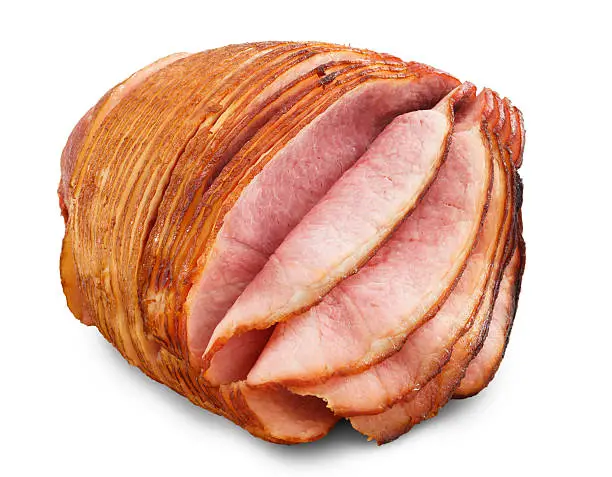Canadians love bacon and ham just as much as anyone else, but while they both have similar origins, the two are different in many ways. From the flavor and texture to the way it’s cooked, there can be considerable differences between Canadian bacon vs ham.
Whether you’re a fan of one or both or neither! it’s always worth understanding exactly what sets them apart so you know which one is best suited for your meal. In this blog post, we’ll explore these differences from nose to tail and figure out once and for all: Canadian bacon vs ham – what’s the difference?
What is Canadian Bacon?

Canadian bacon, also known as back bacon or peameal bacon, is a breakfast staple across Canada and much of the United States. It’s made from cured pork loin, which gives it an elongated shape that can be cut into slices. The curing process uses salt, sugar, spices and sometimes nitrates to give Canadian bacon its signature flavor. It’s typically cooked in a skillet with a bit of oil until it’s crispy on the outside and slightly chewy in the middle.
Canadian Bacon Nutrition Fact:
-Calories: 150
-Fat: 5g
-Sodium: 750mg
-Carbohydrates: 2g
-Protein: 22g
Types of Canadian Bacon
There are two main types of Canadian bacon: regular and smoked. Regular Canadian bacon is usually sold uncooked, while smoked varieties have been cured in a smokehouse for an added flavor. The smoke is typically generated through burning wood chips or sawdust, which gives the Canadian bacon its smoky taste.
What is Ham?

Ham, on the other hand, is made from cured hind leg of pork. It’s usually cut into cubes or steaks and has a much more distinct flavor than Canadian bacon. The curing process used for ham also includes salt, sugar, spices and sometimes nitrates to give it its signature flavor. However, because this part of the pig tends to be fattier than the loin used in Canadian bacon, ham is usually softer and juicier when cooked.
Ham Nutrition Facts:
-Calories: 140
-Fat: 5g
-Sodium: 900mg
-Carbohydrates: 0g
-Protein: 20g
Types of Ham
Similar to Canadian bacon, there are three main types of ham: fresh, cured and smoked. Fresh ham is not usually sold in stores and requires further preparation before it can be cooked. Cured hams are the most common type found in supermarkets, with either a wet or dry curing process used. Lastly, smoked ham has been cooked over an open flame for added flavor.
The Difference Between Canadian Bacon and Ham
Although these two cuts of pork are both delicious and versatile, there are several key differences between Canadian bacon and ham:
1. Cut – Canadian bacon typically comes from the lean top loin cut of pork while ham is taken from the hind leg. The difference in cuts also means that Canadian bacon has less fat than traditional ham.
2. Taste – Thanks to its curing process, Canadian bacon has milder flavor than regular ham which gives it a more subtle taste overall. It is also less salty, making it a great option for those who prefer their bacon on the mild side.
3. Texture – Canadian bacon and ham both have a unique texture but they differ slightly in how they feel when cooked. Canadian bacon is often more firm than traditional ham which makes it ideal for recipes that require crisping or frying.
4. Preparation – When cooking with Canadian bacon, you simply need to heat it up whereas ham needs to be cooked slowly until its internal temperature reaches 140 degrees Fahrenheit (60 degrees Celsius). It’s important to cook ham all the way through otherwise it can become dry and tough.
Similarities of Canadian Bacon vs Ham
Although there are many differences between Canadian bacon and ham, there are a few similarities as well. Both have a savory, salty flavor that makes them perfect for breakfast dishes like omelets or egg sandwiches. They can also both be cooked in a variety of ways such as frying, roasting and grilling, depending on the recipe.
5 Popular Canadian Bacon or Ham Dishes
1. BLT Sandwich – A classic sandwich made with bacon, lettuce, tomato and mayo! Try it with Canadian bacon for a slightly milder flavor.
2. Macaroni & Cheese – For a delicious twist on the classic dish, add some chopped Canadian bacon or ham to your macaroni and cheese recipe!
3. Omelet – Start your day off right with an omelet filled with diced ham and vegetables of your choice.
4. Pizza – Put a spin on your favorite pizza by adding slices of Canadian bacon or some cubed ham to the top before baking in the oven.
5. Quiche – Make a savory quiche packed full of ham and veggies for a hearty breakfast, lunch or dinner.
Canadian Bacon vs Ham Which Is Better?
The answer to this question really depends on personal preference. Both Canadian bacon and ham are delicious and versatile so it ultimately comes down to taste. If you prefer a milder flavor, Canadian bacon is the way to go while those who like a deeper, smokier taste may be better suited for traditional ham. Whatever you decide, both of these pork products make great additions to breakfast or lunch dishes. So why not try them both and see which one you like best!
Which is Healthier: Canadian Bacon vs Ham?
In terms of nutritional value, Canadian bacon is the healthier option when compared to ham. One serving of Canadian bacon (100g) contains:
-Calories: 120
-Fat: 2.5g
-Sodium: 300mg
-Carbohydrates: 0g
-Protein: 15g
A serving of regular ham (100g) contains the following cal 8rileid fatsZer and other nutrients which are essential for good health. However, it is important to note that ham does contain more saturated fat than Canadian bacon and should be consumed in moderation.
When it comes down to it, both Canadian bacon and ham are tasty additions to a wide variety of dishes. It just depends on your personal preference in terms of taste and nutrition!
Credit: Eater
How to Use Canadian Bacon and Ham
Canadian bacon and ham can be used in a variety of dishes from breakfast to dinner. Canadian bacon is often used as a topping for pizzas, sandwiches or salads while ham can be cubed and added to casseroles or soups for extra flavor. Both make tasty additions to omelets, macaroni and cheese, quiches and frittatas. They also work well when used as stuffing ingredients for chicken, pork chops or even vegetables like peppers. Try experimenting with both options to find the perfect dish!
FAQs: Canadian Bacon vs Ham
What is the difference between Canadian bacon and ham?
The main difference between Canadian bacon and ham lies in their flavors and textures. Canadian bacon is usually leaner, milder in flavor and more firm than traditional ham which makes it ideal for recipes that require crisping or frying.
Is one healthier than the other?
In terms of nutritional value, Canadian bacon is the healthier option when compared to ham as it contains slightly fewer calories, fat and sodium per serving.
How can I use Canadian bacon or ham in my cooking?
Both make tasty additions to omelets, macaroni and cheese, quiches and frittatas. They can also be used as a topping for pizzas, sandwiches or salads or cubed and added to casseroles or soups for extra flavor. Try experimenting with both options to find the perfect dish!
Are Canadian bacon and ham interchangeable in recipes?
Yes, they are often interchangeable in recipes, however it is important to note that Canadian bacon has a milder flavor than traditional ham so you may want to adjust your seasoning accordingly. Additionally, depending on the recipe, you may need to adjust cooking times as Canadian bacon cooks more quickly due to its leaner texture. Overall, Canadian bacon and ham are delicious additions to any meal!
Why is it called Canadian bacon and not ham?
The term ‘Canadian bacon’ is actually a misnomer as it is made from pork loin, not bacon. The name likely comes from the fact that it originated in Canada and was popularized there before becoming widely available elsewhere. This leaner, milder meat is often used interchangeably with ham in recipes but has a unique flavor and texture all its own. Canadian bacon makes a great addition to pizzas, sandwiches, salads and more! Try adding it to your next meal for an added layer of flavor!
Is Canadian bacon really bacon or is it ham?
Canadian bacon is not really bacon or ham, but rather a leaner cut of pork loin. It has a milder flavor and firmer texture than regular ham which makes it perfect for recipes that require crisping or frying. Canadian bacon can be used interchangeably with ham in recipes, so why not try adding it to your next meal and see what you think? You might just discover a new favorite! So give it a go – you might just surprise yourself! Experiment with both Canadian bacon and ham to find the perfect dish for your taste buds. Compare and contrast the flavors of each to get an idea of what works best for you. Then use them together in dishes to create something truly unique!
Can I substitute ham for Canadian bacon?
Yes, you can substitute ham for Canadian bacon in many recipes. However, keep in mind that the flavor and texture of Canadian bacon is milder and firmer than traditional ham. Additionally, depending on the recipe, you may need to adjust cooking times as Canadian bacon cooks more quickly due to its leaner texture. Overall, both options are delicious additions to any meal and it’s up to you which one you choose! Explore both options and find out what works best for your tastes. Enjoy! Experimentation with both options will help you discover new flavors and textures for a truly unique culinary experience! With some knowledge about each meat’s flavor profile, similar cooking techniques and nutritional benefits – you have all the tools you need to create something special!
Conclusion
While they are both tasty cuts of pork, there are several differences between Canadian bacon and ham that make them unique. From the cut of meat to the flavor, texture and preparation methods, there are key points to consider when deciding which one is best for your dish. Whether you prefer a milder bacon or an intense smoky ham, understanding these differences will help you pick the perfect pork for your meal!
References

James Burney is the founder of Acadia House Provisions is a restaurant that with local & upscale dishes and high-quality kitchen supplies and food products. James was born and raised in Maine, and he has always been passionate about cooking. After working in a number of prestigious restaurants he started Acadiahouseprovisions.com with the goal develop into a comprehensive information site specializing in cooking and cuisine. His goal is to make it easy for people to cook delicious meals at home without spending a fortune.
